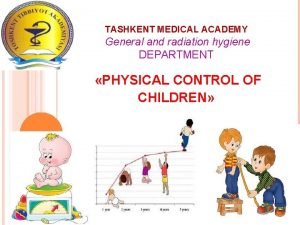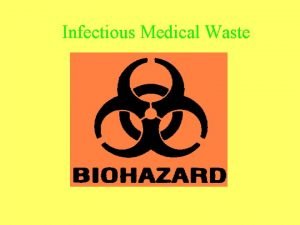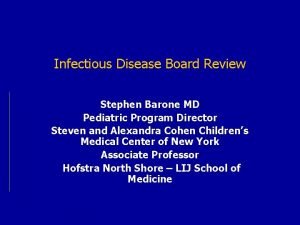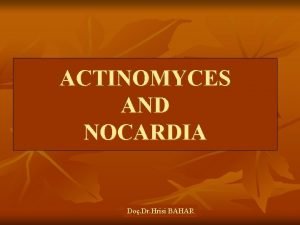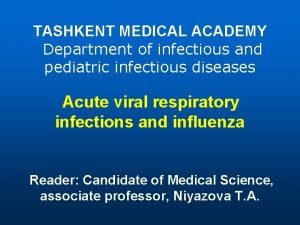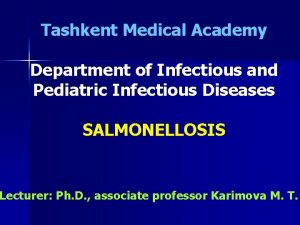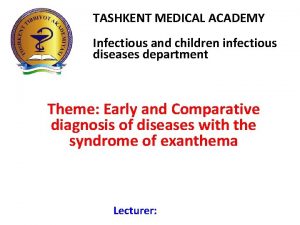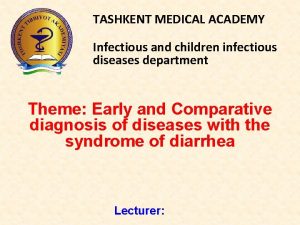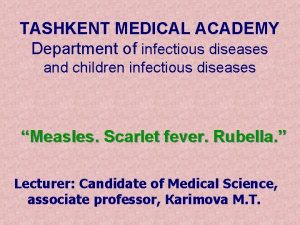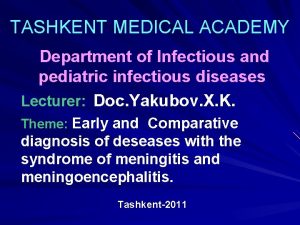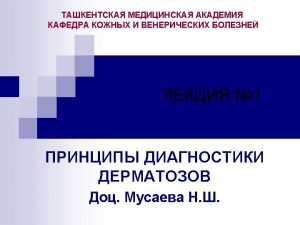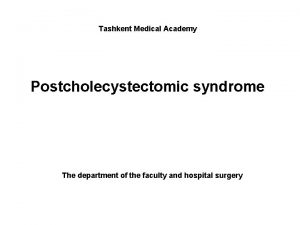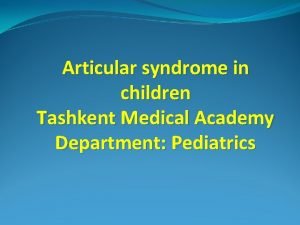TASHKENT MEDICAL ACADEMY Department of infectious and pediatric



















- Slides: 19

TASHKENT MEDICAL ACADEMY Department of infectious and pediatric infectious diseases Diphtheria Reader:

Diphtheria An acute, highly contagious toxin-mediated infection, diphtheria is caused by Corynibaterium diphtheriae, a grampositive rod that usually infects the respiratory tract, primarily involving the tonsils, nasopharynx and larynx.

Diphtheria Greek diphthera (leather hide) Caused by Aerobic Gram positive rods Cornyebacterium diphtheriae Exotoxin production only if infected by virus phage infected carrying toxin gene

Gram positive Bacilli and Colonies

Diphtheria Epidemiology Reservoir Human carriers Usually asymptomatic Transmission Respiratory Skin and fomites rarely Temporal pattern Winter and spring Communicability Up to several weeks without antibiotics

Diphtheria Epidemiology The source of infection - patients or healthy carriers of toxigenic diphtheria bacteria. The greatest danger is posed by an epidemic of diphtheria patients throat, nose and throat, actively secrete infective in the environment in expired air (less dangerously ill with diphtheria eyes, skin, wounds and other sites that can spread the infection by contact (through hands, utensils). Infective ability of healthy toxigenic bacteria carriers in ten times lower than patients with damage to tissues of the respiratory tract.

Pathogenesis The entrance gate - almost all of the integument (skin and mucous membranes) of macro organism (usually oropharyngeal mucosa, much less often - the larynx, nose, conjunctival, genital, wound surface, skin, etc. ) Toxigenic Corynebacterium fixed to the tissue cells, multiply, and in the process of life produce an exotoxin.

Classification of diphtheria Localization Degree of edema Severity of diphtheria Toxic diphtheria I degree Easy form Toxic diphtheria II degree Средней тяжести Main complications Myocarditis (early, late) Stage of severity of complications Compensated Polineyropatia Fauces Toxic nephritis Subcompensated Croup Severe form ДВС-синдром Combined Toxic diphtheria III degree Fulminant form Toxic shock syndrome Acute renal failure (ARF) Decompensate

Diphtheria Clinical Features Incubation period 2 -5 days (range, 1 -10 days) May involve any mucous membrane Classified based on site of infection Ø anterior nasal Ø pharyngeal and tonsillar Ø laryngeal Ø cutaneous Ø ocular Ø genital

Pharyngeal and Tonsillar Diphtheria Insidious onset of exudative pharyngitis Exudate spreads within 2 -3 days and may form adherent pseudo membrane Membrane may cause respiratory obstruction Fever usually not high but patient appears toxic

Thick Membrane

Pseudo membrane


‘Bull Neck’

Skin Lesions

Diphtheria Complications Mostly attributable to toxin Severity generally related to extent of local disease Most common complications are myocarditis and toxic neuritis with palsy Death occurs in 5%-10% for respiratory disease

Diphtheria Antitoxin (DAT) Produced in horses First used in the U. S. in 1891 Used only for treatment of diphtheria Neutralizes only unbound toxin


DTa. P (АКДС) Age Name of vaccine 2 month DTa. P-1 3 month DTa. P-2 4 month DTa. P-3 9 month DTa. P-4 7 years old DTa. M-5 16 -17 years old DTa. M-6 26 years old DTa. M-7 46 years old DTa. M-8
 Tashkent medical academy fee structure
Tashkent medical academy fee structure Uztesting
Uztesting Tashkent information technology university
Tashkent information technology university Maro tashkan
Maro tashkan Chapter 26 infectious disease prevention and control
Chapter 26 infectious disease prevention and control Icd 10 morbus hansen
Icd 10 morbus hansen Skeleton hand whmis
Skeleton hand whmis Mebosha
Mebosha Infectious disease quality controls
Infectious disease quality controls Stages of infection
Stages of infection Stages of infectious disease
Stages of infectious disease Infectious canine hepatitis in dogs
Infectious canine hepatitis in dogs Stridor
Stridor Viruses are the smallest infectious agents
Viruses are the smallest infectious agents Infectious canine hepatitis in dogs
Infectious canine hepatitis in dogs Infectious nucleic acid
Infectious nucleic acid Lead poisoning
Lead poisoning Infectious disease
Infectious disease Ebv
Ebv Hennepin county infectious disease manual
Hennepin county infectious disease manual
